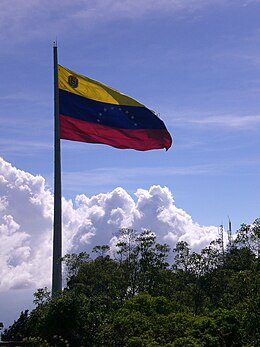El Ávila
| El Ávila National Park | |
|---|---|
|
IUCN category II (national park)
|
|
 |
|
|
Location of El Ávila National Park
|
|
| Coordinates | 10°32′N 66°52′W / 10.533°N 66.867°WCoordinates: 10°32′N 66°52′W / 10.533°N 66.867°W |
| Area | 81,900 ha (316 sq mi) |
| Established | 12 December 1958 |
| Governing body | INPARQUES |
| Cerro El Ávila | |
|---|---|
| Highest point | |
| Elevation | 2,765 m (9,072 ft) |
| Coordinates | 10°32′N 66°52′W / 10.533°N 66.867°W |
| Geography | |
| Location | Caracas, Venezuela |
| Parent range | Cordillera de la Costa |
The El Ávila National Park (or Waraira Repano, from an indigenous name for the area) protects part of the Cordillera de la Costa Central mountain range, in the coastal region of central-northern Venezuela.
El Ávila National Park is located along the central section of the Cordillera de la Costa mountain system, in the Cordillera de la Costa Central mountain range.The area's highest elevation is Pico Naiguatá, at 2,765 meters (9,072 ft) above sea level.
El Ávila is known as "el pulmón de la ciudad", the lungs of the city, as it serves many different functions for residents of Caracas, the most basic of these being navigation: the peak of El Ávila marks the north of the city. It is home to the longest cable car ride in the world, as well as activities like running, biking, rock climbing, camping, and zip-lining. El Hotel Humboldt as well as many restaurants, including La Chivera, Casa Pakea, El Jardín de Luna, Le Galipanier, Granja Natalia and Tarahumara, are all nestled in the mountain's hills. Every December, the "Cruz de Navidad" is illuminated, a large crucifix high up in the mountain that faces the city and can be seen from very far distances.
A common expression amongst Caracas city-dwellers to describe the change in seasons is "Pacheco has arrived," which is a reference to the legend of Pacheco the flower-picker. He was known to be a resident of el Galipán, a region in el Ávila close to the coast that tended to mark the border between the coast's chilly weather and that of the hot, dry weather of the rest of the country. El Galipán was home to some of the most beautiful, unique flowers in the country, and every December Pacheco would make the long trip down the mountain into the city to sell his harvest in the Plaza Bolivar in Caracas. His arrival was often accompanied by the cold December weather, and over time, the expression "Pacheco has arrived" came to mean that the weather is about to get colder.
El Ávila was declared a park in 1958, fulfilling an interest in its protection that had been prevalent since the 19th century. With its creation came the protection of the forested mountains that surround Caracas, the capital of Venezuela. These mountains now serve as both a recreational area and as a buffer to pollution and urban expansion. El Ávila has always been an important resource for the inhabitants of Caracas, who have used the area for a variety of activities, some of which have threatened its conservation. A hotel and a cable car, which climbs to the highest point at 2,135 meters (7,005 ft) above sea level and drops down the other side to the city of Macuto, were opened in 1956. After being out of service for 20 years, this cable car was reopened in February 2002.
...
Wikipedia

